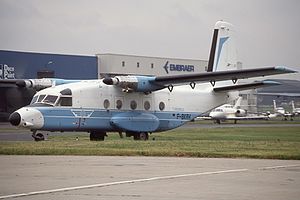Nord 260
| Nord 260 | |
|---|---|
 |
|
| Nord 260A. | |
| Role | Passenger turboprop |
| National origin | France |
| Manufacturer | Avions Max Holste, Nord Aviation |
| Designer | Max Holste |
| First flight | 29 July 1960 |
| Number built | 9 (1 x MH-260 and 8 x Nord 260) |
| Unit cost |
$295,000 in 1961
|
| Developed from | Max Holste MH.250 Super Broussard |
| Variants | Aérospatiale N 262 |
The Nord 260, built in prototype form as the Max Holste MH.260 Super Broussard, ("Super Bushranger"), was a turboprop-powered, uprated version of the piston-engined Max Holste MH.250 Super Broussard, that was further developed into the Aérospatiale N 262.
The MH.260 was designed in partnership with Nord Aviation to carry 23 passengers or 3,445 kg (7,595 lb) of cargo on short fields, as a modern equivalent of the DC-3.
The MH.260 was a high-wing, twin-engine turboprop aircraft powered by 731 kW (980 hp) Turbomeca Bastan engines. The fuselage was of all -aluminum construction with fabric covered control surfaces. The landing gear retracted into fuselage-mounted fairings.
The prototype was built at a Nord Aviation facility, so it followed naturally that production aircraft should also be built there. The MH-260 design was taken over by Nord and production was commenced to fill a French government order for ten aircraft under the designation Nord 260. No orders were received from outside the government as the nascent Nord 262 offered better performance. Eight Nord 260s were completed and delivered to a few airlines on lease for short periods before final delivery to the French Air Force at CEV Bretigny.
Data from MH-260 Super Broussard
General characteristics
Performance
...
Wikipedia
